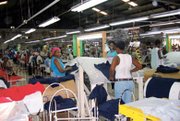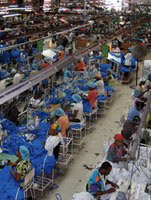Sewing With Renewed HOPE in Haiti
The heat was stifling in the cavernous space in an industrial park near Port-au-Prince’s international airport. Yet many of the 600 workers in the Caribbean Apparel Manufacturing S.A. factory were smiling as they worked in small module groups, sewing T-shirts and men’s underwear for companies Gilden and Grana.
The smiles on the faces of the CAMSA employees could have been prompted by the unexpected presence of a reporter taking notes and snapping photos. Or it could be the prospect of steady employment after several years of declining work for Haiti’s apparel factories and their workers.
Haiti was once a much larger player in the Caribbean apparel market, but production in the Caribbean nation dropped off during the last two decades because of political unrest, economic decline and growing competition from the Far East.
But industry observers in Haiti and the United States are optimistic about the industry’s future under the Haitian Hemispheric Opportunity Through Partnership Encouragement Act (HOPE), a trade preference enacted in late 2006 and up for renewal at the end of the year.
HOPE’s benefits are similar to those of the Dominican Republic–Central American Free Trade Agreement with two major differences. Unlike DR-CAFTA, which only applies to knits, HOPE allows both knit and woven goods produced in Haiti to be imported to the United States duty-free. The act also allows companies to use fabric from anywhere in the world to produce apparel in Haiti and still import them to the United States duty- free.
“Haiti has a very favorable preference, which provides the user [the ability] to utilize low-cost inputs from around the world and still maintain duty-free access to the U.S. marketplace,” said Tom Travis, managing partner of international trade and customs law firm Sandler, Travis & Rosenberg P.A. and chairman of Sandler & Travis Trade Advisory Services, which provides management services for customs-compliance and global security matters. “[HOPE] is similar to the preferences provided to Egypt and Jordan under the qualified industrial-zones concept.”
Under HOPE, apparel can be imported duty-free from Haiti as long as at least 50 percent of the value of the materials meet certain requirements. Materials can be from the United States, Haiti, a country with a freetrade agreement with the United States or one of the United States’ regional preferenceprogram partner countries. The act limits the quantity of goods eligible for HOPE’s benefits to 1 percent of overall U.S. apparel imports in the first year. If HOPE is renewed, that limit will gradually rise over five years to 2 percent.
There’s little chance Haitian imports will exceed HOPE’s limits. In 2006, apparel imports from Haiti to the United States totaled $242 million, according to the U.S. Department of Commerce. Worldwide apparel imports to the United States totaled $71.6 billion. So far this year, apparel imports from Haiti totaled $257 million, according to the Department of Commerce’s latest figures released in July, and worldwide apparel imports totaled $41.4 billion.
Reviving an industry
Haiti’s apparel-industry veterans are counting on HOPE’s benefits to revive the country’s once-thriving industry.
In the 1980s there were more than 90 companies in the light-manufacturing sector, according to George Sassine, a former garment manufacturer and consultant for HOPE.
“Plush toys, electronic parts, baseballs, leather goods, jewelry and garments made up a vibrant and promising sector,” he said. “Of these, more than 50 were Haitian-owned.”
According to the U.S. State Department, Haiti’s assembly manufacturing sector employed 100,000 people in the 1980s.
The apparel industry—like much of Haiti’s business sector—fell into decline after President Jean-Betrande Aristide was ousted in a 1991 military coup. The United Nations issued an embargo in 1994, limiting the import of goods into Haiti to humanitarian supplies such as food and medicine. During the embargo, Haiti’s assembly employment dropped to below 17,000.
But in recent years, Haiti’s employment has slowly climbed. Today, there are 18,500 employed in the assembly sector, according to the State Department. And the dollar value of Haiti’s apparel exports has more than doubled since 2002. The export of apparel and household goods from Haiti to the United States grew by more than 100 percent from $218 in 2002 to $450 million in 2006, according to U.S. Census statistics on foreign trade.
But while Haiti’s industry is slowly recovering, much of the recovery effort is coming in the form of foreign investment, according to Sassine.
“Today, there are 17 garment manufacturers: three American, eight Haitian and the rest is owned by Dominicans and Koreans,” he said. These days, Haitian factories are producing basic commodity items such as T-shirts and scrubs—a far cry from the country’s history as a center for more-complicated apparel items such as bridal dresses and flannel shirts. However, Sassine said some morecomplicated items such as jeans and uniforms are coming back to the region. Still, commodity goods represent the lion’s share of Haiti’s production. According to Sassine, the country’s top apparel employer, Gilden, is producing more than 100,000 dozen T-shirts a week in Haitian factories.
“Haitian apparel workers were skilled, but this level dropped considerably when the embargo was imposed in 1992, and more than 85,000 lost their jobs and had to recycle themselves,” said Sassine, who spent nearly 35 years in Haiti’s garment industry producing childrenswear for H.H. Cutler, which made apparel for companies including Disney, Gerber, Kahn Lucas Lancaster and Doe Spun.
“Today, the lower-value garments being manufactured require strength and stamina more than dexterity,” Sassine said.
And while Haiti represents a low-cost labor alternative for U.S. manufacturers, for Haiti’s garment workers, apparel jobs represent a step up from the legal minimum daily wage.
According to Sassine, Haiti’s garment workers typically earn 150 gourdes a day—or about $4.30 in U.S. currency. Haiti’s legal minimum wage is 70 gourdes per day.
But inexpensive labor is not Haiti’s only selling point, Sassine said. “Haiti’s attraction is not the low wages but the capacity to answer quickly to orders due to the proximity and also the great pool of available labor,” he said. “The main idea behind HOPE is to help create much-needed jobs in Haiti. Apparel manufacturing [is a] sector where jobs can be created very fast. Because so many Haitians are trained in this field, we can expect to reclaim over 10,000 jobs within the next year and quadruple that in the coming five years. Haiti is near, inexpensive and available. [It’s a] good formula for profit.”























